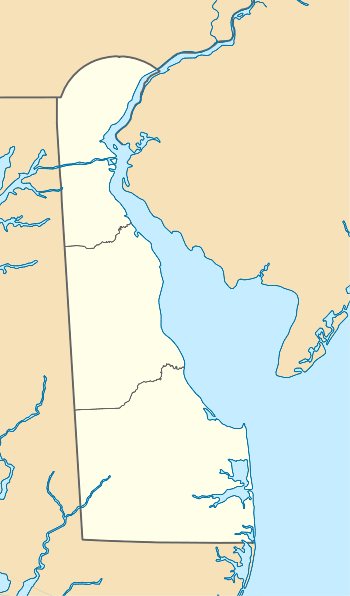Delaware Museum of Natural History
The Delaware Museum of Natural History (DMNH) was founded in 1957 by John Eleuthere du Pont near Greenville, Delaware; it opened in 1972 on a site near Winterthur, Delaware. It is known for its extensive collections of seashells, birds, and bird eggs. The latter is the second largest collection in North America. It is the oldest natural history museum in Delaware.
 Museum in 2010 | |
 Location in Delaware | |
| Established | 1957 (open to public May 13, 1972) |
|---|---|
| Location | 4840 Kennett Pike, Wilmington, Delaware, 19807 USA 302.658.9111 |
| Coordinates | 39.798307°N 75.609804°W |
| Type | Natural history |
| Visitors | Over 65,000[1] |
| Public transit access | |
| Website | www |
History
The museum's core collection was started in childhood by the naturalist, philanthropist and high-profile convicted murderer [2][3][4] John E. ("Golden Eagle") du Pont. Du Pont built a personal collection of seashells, birds and bird eggs. Even before getting a doctorate in natural science in 1965 and writing several books on birds, he became interested in developing a natural history museum. During and after graduate school, du Pont took part in several scientific expeditions to the South Pacific and the Philippines, and is credited with the discovery of two dozen subspecies of birds.
At his request, his uncle Henry Francis du Pont provided land across from the Winterthur estate in the Brandywine Valley of Delaware for the museum. The museum opening in 1972 was attended by 200 du Pont family members, and representatives of other Northeastern natural history museums.[5] It was the first major museum of natural history opened since 1910.[6]
The museum originally was based on du Pont's collection of 1,000,000 sea shells and 100,000 bird eggs. The museum emphasizes the ecology of birds and sea life. In early studies, these were used by scientists to measure pesticide contamination of wild species.[6] DMNH is ranked in the top fifteen in the United States for its collections of mollusks and birds, with the second largest collection of birds' eggs in North America.[7]
The museum had a major expansion in 2005 to add educational and exhibit space. It has been expanded to include exhibits on dinosaurs, mammals, and Charles Darwin.[8]
References
- "About Us". Delaware Museum of Natural History. Retrieved December 19, 2015.
- Longman, Jeré (December 10, 2010). "John E. du Pont, Heir Who Killed an Olympian, Dies at 72". The New York Times. Retrieved February 9, 2020.
- Goddard, Jacqui (January 4, 2015). "Foxcatcher: the true story". The Telegraph. Retrieved February 9, 2020.
- Cormier, Ryan (November 29, 2014). "'Foxcatcher' book details du Pont murder plot". The News Journal. Wilmington, DE. Retrieved February 9, 2020.
- Janson, Donald (May 13, 1972). "DuPonts Toast a New Museum". The New York Times. Retrieved July 12, 2009.
- Janson, Donald (May 7, 1972). "New Museum in Delaware Stresses Ecology of Birds and Sea Life". The New York Times. Retrieved July 12, 2009.
- "Collections and Research". Delaware Museum of Natural History.
- "Permanent Exhibits". Delaware Museum of Natural History. Retrieved July 12, 2009.
External links
| Wikimedia Commons has media related to Delaware Museum of Natural History. |